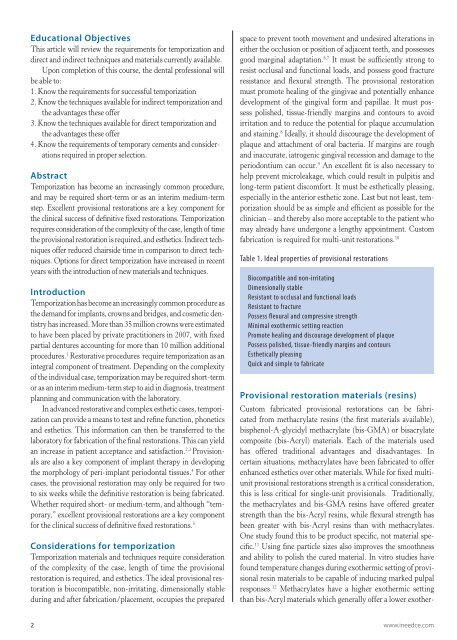Contemporary Temporization - IneedCE.com
Contemporary Temporization - IneedCE.com
Contemporary Temporization - IneedCE.com
You also want an ePaper? Increase the reach of your titles
YUMPU automatically turns print PDFs into web optimized ePapers that Google loves.
Educational Objectives<br />
This article will review the requirements for temporization and<br />
direct and indirect techniques and materials currently available.<br />
Upon <strong>com</strong>pletion of this course, the dental professional will<br />
be able to:<br />
1. Know the requirements for successful temporization<br />
2. Know the techniques available for indirect temporization and<br />
the advantages these offer<br />
3. Know the techniques available for direct temporization and<br />
the advantages these offer<br />
4. Know the requirements of temporary cements and considerations<br />
required in proper selection.<br />
Abstract<br />
<strong>Temporization</strong> has be<strong>com</strong>e an increasingly <strong>com</strong>mon procedure,<br />
and may be required short-term or as an interim medium-term<br />
step. Excellent provisional restorations are a key <strong>com</strong>ponent for<br />
the clinical success of definitive fixed restorations. <strong>Temporization</strong><br />
requires consideration of the <strong>com</strong>plexity of the case, length of time<br />
the provisional restoration is required, and esthetics. Indirect techniques<br />
offer reduced chairside time in <strong>com</strong>parison to direct techniques.<br />
Options for direct temporization have increased in recent<br />
years with the introduction of new materials and techniques.<br />
Introduction<br />
<strong>Temporization</strong> has be<strong>com</strong>e an increasingly <strong>com</strong>mon procedure as<br />
the demand for implants, crowns and bridges, and cosmetic dentistry<br />
has increased. More than 35 million crowns were estimated<br />
to have been placed by private practitioners in 2007, with fixed<br />
partial dentures accounting for more than 10 million additional<br />
procedures. 1 Restorative procedures require temporization as an<br />
integral <strong>com</strong>ponent of treatment. Depending on the <strong>com</strong>plexity<br />
of the individual case, temporization may be required short-term<br />
or as an interim medium-term step to aid in diagnosis, treatment<br />
planning and <strong>com</strong>munication with the laboratory.<br />
In advanced restorative and <strong>com</strong>plex esthetic cases, temporization<br />
can provide a means to test and refine function, phonetics<br />
and esthetics. This information can then be transferred to the<br />
laboratory for fabrication of the final restorations. This can yield<br />
an increase in patient acceptance and satisfaction. 2,3 Provisionals<br />
are also a key <strong>com</strong>ponent of implant therapy in developing<br />
the morphology of peri-implant periodontal tissues. 4 For other<br />
cases, the provisional restoration may only be required for two<br />
to six weeks while the definitive restoration is being fabricated.<br />
Whether required short- or medium-term, and although “temporary,”<br />
excellent provisional restorations are a key <strong>com</strong>ponent<br />
for the clinical success of definitive fixed restorations. 5<br />
Considerations for temporization<br />
<strong>Temporization</strong> materials and techniques require consideration<br />
of the <strong>com</strong>plexity of the case, length of time the provisional<br />
restoration is required, and esthetics. The ideal provisional restoration<br />
is bio<strong>com</strong>patible, non-irritating, dimensionally stable<br />
during and after fabrication/placement, occupies the prepared<br />
space to prevent tooth movement and undesired alterations in<br />
either the occlusion or position of adjacent teeth, and possesses<br />
good marginal adaptation. 6,7 It must be sufficiently strong to<br />
resist occlusal and functional loads, and possess good fracture<br />
resistance and flexural strength. The provisional restoration<br />
must promote healing of the gingivae and potentially enhance<br />
development of the gingival form and papillae. It must possess<br />
polished, tissue-friendly margins and contours to avoid<br />
irritation and to reduce the potential for plaque accumulation<br />
and staining. 8 Ideally, it should discourage the development of<br />
plaque and attachment of oral bacteria. If margins are rough<br />
and inaccurate, iatrogenic gingival recession and damage to the<br />
periodontium can occur. 9 An excellent fit is also necessary to<br />
help prevent microleakage, which could result in pulpitis and<br />
long-term patient dis<strong>com</strong>fort. It must be esthetically pleasing,<br />
especially in the anterior esthetic zone. Last but not least, temporization<br />
should be as simple and efficient as possible for the<br />
clinician – and thereby also more acceptable to the patient who<br />
may already have undergone a lengthy appointment. Custom<br />
fabrication is required for multi-unit restorations. 10<br />
Table 1. Ideal properties of provisional restorations<br />
Bio<strong>com</strong>patible and non-irritating<br />
Dimensionally stable<br />
Resistant to occlusal and functional loads<br />
Resistant to fracture<br />
Possess flexural and <strong>com</strong>pressive strength<br />
Minimal exothermic setting reaction<br />
Promote healing and discourage development of plaque<br />
Possess polished, tissue-friendly margins and contours<br />
Esthetically pleasing<br />
Quick and simple to fabricate<br />
Provisional restoration materials (resins)<br />
Custom fabricated provisional restorations can be fabricated<br />
from methacrylate resins (the first materials available),<br />
bisphenol-A-glycidyl methacrylate (bis-GMA) or bisacrylate<br />
<strong>com</strong>posite (bis-Acryl) materials. Each of the materials used<br />
has offered traditional advantages and disadvantages. In<br />
certain situations, methacrylates have been fabricated to offer<br />
enhanced esthetics over other materials. While for fixed multiunit<br />
provisional restorations strength is a critical consideration,<br />
this is less critical for single-unit provisionals. Traditionally,<br />
the methacrylates and bis-GMA resins have offered greater<br />
strength than the bis-Acryl resins, while flexural strength has<br />
been greater with bis-Acryl resins than with methacrylates.<br />
One study found this to be product specific, not material specific.<br />
11 Using fine particle sizes also improves the smoothness<br />
and ability to polish the cured material. In vitro studies have<br />
found temperature changes during exothermic setting of provisional<br />
resin materials to be capable of inducing marked pulpal<br />
responses. 12 Methacrylates have a higher exothermic setting<br />
than bis-Acryl materials which generally offer a lower exother-<br />
2 www.ineedce.<strong>com</strong>

















